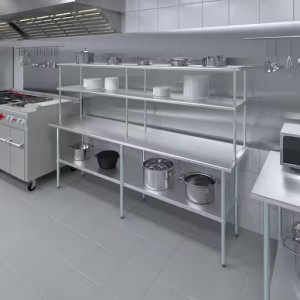68 11.1 Construction Materials

Careful consideration of construction material is important when selecting foodservice equipment. Some metals, paints, and other materials used to construct equipment can leach chemicals and contaminate food, resulting in toxic poisoning. Food contact surfaces, if designed or constructed poorly, can also contaminate food by harboring microorganisms in the seams, internal corners, cracks, pits and chips. Equipment must maintain its integrity throughout its lifetime and withstand the harsh chemicals used for continuous cleaning and sanitizing.
The FDA requires that all food contact surfaces be safe, non-absorbent, durable, corrosion-resistant, and smooth. Stainless steel is the most popular and recommended material that meets these guidelines. There are many types of stainless steel, but the most common in commercial kitchens are those from the 300 series, which contain carbon, chromium, and nickel. 304 Stainless steel is suitable for most food contact surfaces but will rust if heavy exposure to corrosives. 316 Stainless steel is highly resistant to corrosion; however, it has a higher cost compared to other stainless-steel varieties.
Finishes typically range from highly polished to brushed, which can affect corrosion resistance. The gauge of metal indicates the thickness, which is important to the durability of the equipment. If a metal is too thin, it can dent, crack, or break, which can result in unsafe conditions. The typical gauge range of stainless steel for commercial kitchen use is 18 to 14. A gauge of 18 is the thinnest and used in economy equipment. A gauge of 14 is the best as it is thick enough to withstand heavy-duty usage.
Galvanized metal (iron or steel) is not approved for food contact surfaces. This is metal that has been coated in hot zinc to produce a rust-proof surface. Cast Iron does meet the requirements of durability; however, due to its porous surface, it can be difficult to clean. Therefore, limiting cast iron to cooking surfaces where the heat can destroy pathogens is strongly encouraged. Despite the material used to construct the equipment, it must be certified as food-safe.
The non-food contact surfaces of equipment should be constructed of durable, non-absorbent materials that can withstand regular cleaning. For example, the doors of a refrigerator and storage shelving are non-food contact surfaces.
an article that is used in the operation of a food establishment such as a freezer, grinder, hood, ice maker, meat block, mixer, oven, reach-in refrigerator, scale, sink, slicer, stove, table, temperature measuring device for ambient air, vending machine, or warewashing machine.
